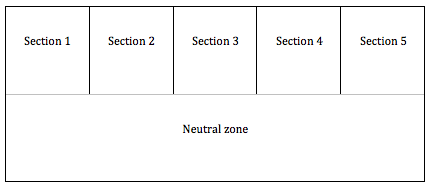Haliotis asinina feeding preference on Heron Island algae.
Introduction
Haliotis asinina is the largest of the tropical abalone and is found around the Indo Pacific Region (McNamara and Johnson 1995). H. asinina have been recorded with a shell length of up to 120mm on Heron Island. This maximum shell length is not standard throughout its distribution (McNamara and Johnson 1995), as it is also found in Thai waters where it reaches a maximum length of 90mm (Singhagraiwan and Sasaki 1991). This could be due to environmental factors such as water quality but it could also be due to the diet and the availability of different food across the Indo Pacific. A study in the Philippines found that H. asinina preferred red and brown algae over greens.
This paper aims to see if there is a spatial variation in the diet, which may be the cause of the enhanced growth rate of H. asinina on Heron Island.
Method
Collection
Eight adult H. asinina (shell > 9cm) were collected in September 2011 on the reef flat of Heron Island on the southern side. (23"27'S, 151°55'E) The abalone were then kept in aquaria and not fed for two days prior to the experiment. Five different algae species were also collected from the same area. The species that were collected had representatives from the red, green and brown algae groups. These species included Halameda sp.-green, Padina gymnospora- brown, Chlorodesmis fastigiata- green, Laurencia sp 1- a soft red, Laurencia sp 2- a harder red.
Experimental design
4.5g of each algae species were lightly squeezed to remove excess water, then randomly placed within different sections of a plastic cage (570x320x94mm) and secured with wire (Fig 1). One large abalone (86-101mm shell) was placed in the centre of the neutral zone of each cage. The cages were then submerged under water in a holding tank and left for 10 hours (2030h-0630h). Every hour from the start of the experiment the location of the abalone was recorded. This was then replicated the following night.

Figure 1: set up of the abalone cage. 1 of 5 algae species were randomly placed into each section of the cage and the abalone was placed in the centre of the neutral zone.
Results
Red algae were the most consumed. Laurencia sp. 1 was the preferred algae species with an average of 79.5% being consumed across the 4 replicates (P<0.5) (fig 2). Laurencia sp 2 was the second most consumed but this was not statistically different from the other algae species.
The abalone spent the most time with red algae, which was 32.5% of sightings (table 1). 15% of sightings they were close to green algae and 7.5% of sightings they were near the brown algae.

Figure 2: The percentage of 5 different algae species eaten in 10h by H asinine.
Table 1: Time spent by H. asinina in close proximity to 5 different algae species.
|
Time spent in each section
|
|
Species of algae
|
% of sightings
|
|
Halameda sp.
|
5
|
|
Padina gymnospora
|
7.5
|
|
Chlorodesmis fastigiata
|
10
|
|
Laurencia sp 1
|
15
|
|
Laurencia sp 2
|
17.5
|
|
Neutral zone
|
45
|
Discussion
The study confirmed that like other abalone, h. asinina prefer to eat some red and brown algae (Tahil and Juinio-Menez 1999). This was reflected in this paper’s results as Laurencia sp was the highest consumed algae by H. asinina (fig .2). In contrast the other red algae and the brown algae species were consumed in the same amount as the green algae species.
The results also show that there is a great difference in the palatability of algae with in the same genus. This experiment used two Laurencia species, Laurencia sp. 1 was the preferred species over all the other species. In comparison the amount of Laurencia sp. 2 consumed was not different to the other three species. This could indicate that even if Laurencia in growing in other parts of the indo pacific it may not be of the same quality as some of the species growing on Heron Island. A difference in food quality could explain the difference in the maximum growth of H. asinina in the indo pacific.
Acknowledgments
Thanks to Cath Lovelock for help with the identification of algae species. Thanks also to Andrew Calcino for help with the design of the abalone cages. |